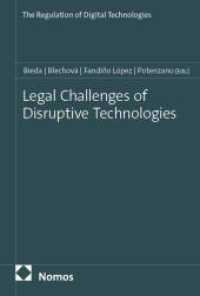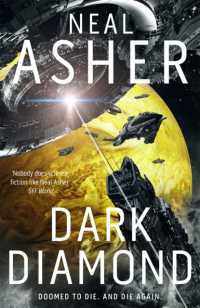- ホーム
- > 洋書
- > 英文書
- > Politics / International Relations
Full Description
This classic text delivers a consistent, clear method for teaching intelligence analysis, demonstrating how a collaborative, target-centric approach leads to sharper and more effective analysis.
Contents
Preface
Acknowledgments
Part I: The Process, The Participants, and the Product
Chapter 1: Introduction
Why Intelligence Fails
What this Book Is About
Summary
Chapter 2: Intelligence in the Age of Contested Norms and Persistent Disorder
Nature of Twenty-First-Century Conflict
Tools of Conflict
Synergy of the Tools
The Function of Intelligence
Summary
Critical Thinking Questions
Chapter 3: The Intelligence Process
The Traditional Intelligence Cycle
Intelligence as a Target-Centric Process
The Target
Summary
Critical Thinking Questions
Chapter 4: The Customer
Overview of Customers
Understanding the Customer
Summary
Critical Thinking Questions
Chapter 5: The Analyst
Critical and Logical Thinking
Objectivity
Broad Perspective
Good Instincts
The All-source Analyst's Role
The Analysis Team
Summary
Critical Thinking Questions
Chapter 6: The Analytic Network
The US National Intelligence Network
Homeland Security and Law Enforcement
Military
Nongovernmental Entities
Network Collaboration and Sharing
Summary
Critical Thinking Questions
Chapter 7: The Intelligence Product
Intelligence Research
Current Intelligence
Indications and Warning
What Should an Intelligence Unit Produce?
Constraints on the Intelligence Product
Summary
Critical Thinking Questions
Part II: The Analysis Process
Chapter 8: The Intelligence Issue
Preliminary Questions
Issue Definition
Issue Decomposition
Summary
Critical Thinking Questions
Chapter 9: Target Models
Modeling the Intelligence Target
General Target Models
Summary
Critical Thinking Questions
Chapter 10: The Target Framework
Creating a Target Framework
Issue 1: Al-Shabaab Ideology
Issue 2: Influencing Azerbaijan
Issue 3: The Monopolitania Biological Warfare Threat
Alternative and Competitive Target Frameworks
Summary
Critical Thinking Questions
Chapter 11: Analyzing Existing Intelligence
Reviewing Existing Finished Intelligence
Acquiring Raw Intelligence
Evaluating Evidence
Combining the Evidence
Structured Argumentation
A Note about the Role of Information Technology
Summary
Critical Thinking Questions
Chapter 12: The Information Sources
Filling Gaps
Using the Issue Decomposition and Target Framework
Identifying Gaps
Developing the Collection Strategy
Executing Collection Strategies
Analyst-Collector Interaction
Evaluating Collection
Collection Requirements
Summary
Critical Thinking Questions
Chapter 13: Denial, Deception, and Signaling
Denial
Deception
Defense against Denial and Deception: Protecting Intelligence Sources and Methods
Countering Denial and Deception
Signaling
Summary
Critical Thinking Questions
Chapter 14: Gaining Customer Acceptance
Structuring the Message
Presenting the Message
Reviewing the Analytic Product
Customer Interaction
Analyst as Advocate: Getting Buy-In
Aftermath: Dealing with Unexpected Outcomes
Summary
Critical Thinking Questions
Part III: Anticipatory Intelligence
Chapter 15: Anticipatory Analysis: Forces
Background Forces
Synergy
Causal Models
Summary
Critical Thinking Questions
Chapter 16: Anticipatory Analysis: Methodology
Convergent and Divergent Phenomena
The Estimative Approach
Unintended Consequences
Summary
Critical Thinking Questions
Chapter 17: Scenarios
Why Use Scenarios?
Types of Scenarios
Scenario Perspectives
How to Construct Scenarios
Example Scenario: Escalation Ladders and Lattices
Summary
Critical Thinking Questions
Chapter 18: Systems Modeling and Analysis
Systems Analysis Methodology
Performance
Process
Risk
Cost
Summary
Critical Thinking Questions
Chapter 19: Relationship Modeling and Analysis
Link Models
Network Models
Network Analysis
Summary
Critical Thinking Questions
Chapter 20: Geospatial Modeling and Analysis
Static Geospatial Models
Dynamic Geospatial Models
Summary
Critical Thinking Questions
Chapter 21: Simulation Modeling
Types of Simulations
Using Simulations
Summary
Critical Thinking Questions
Chapter 22: Prescriptive Intelligence
The Process
Scenarios
Operations Research
Simulations
Prescriptive Analytics
Summary
Critical Thinking Questions
Chapter 23: An AI-Enabled Version of the Target-Centric Approach
Introduction
A Possible Future Scenario
Conclusion: Can This Work?
Summary
Critical Thinking Questions
Chapter 24: Case Study: A Tale of Two NIEs
The Yugoslavia NIE
The Iraq Weapons of Mass Destruction NIE
Capstone Critical Thinking Questions
List of Commonly Used Acronyms
Index
About the Author








